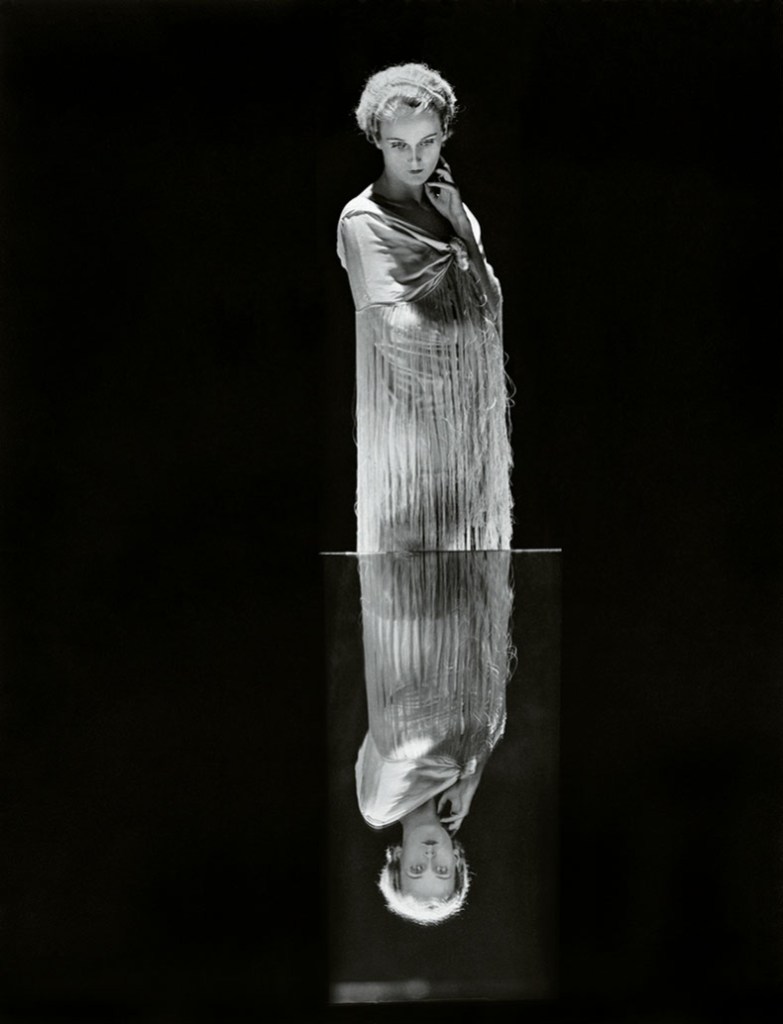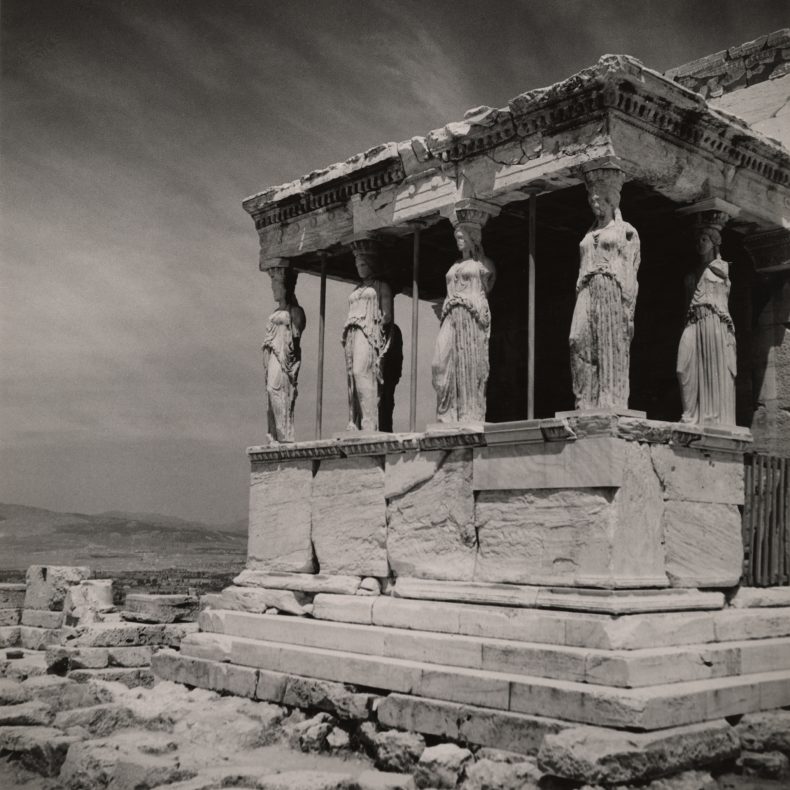This review of George Hoyningen-Huene: Photography, Fashion, Film by Susanna Brown (ed.) appears in the July/August 2024 issue of Apollo. Preview and subscribe here.
Is a model a mannequin, a statue or a living thing? For the early 20th-century fashion photographer, this was a burning question (and not just because the studio lights were so hot). The model was, herself, a relatively new invention, the flesh and blood embodiment of the replica women who went before her: the miniature 18th-century dolls in their miniature example gowns sent out to prospective customers; the usefully proportioned dressmakers’ busts that aided tailoring; the wax dummies with glass eyes and human hair displayed in shop windows. The fashion show, popularised around the turn of the century by designers including Charles Frederick Worth, Lady Duff-Gordon and Paul Poiret, required her ambulatory services as she strolled, drifted and turned, animating the clothing she wore.

Erna Carise and models around a Michelin push-ball, photographed by George Hoyningen-Huene and published in Vogue, 5 July 1930. © The George Hoyningen-Huene Estate Archives
Where the fashion show might have encouraged the model to move, the photographer beckoned her back towards stasis. (Early fashion photography could only move as fast as the technology – confined to the tripod within the studio, gestures had to be held for as long as it took the camera to blink.) As the fashion magazine – another fin-de-siècle invention, with American Vogue founded in 1892 – slowly made the move from illustration to photography, the display of clothes on the printed page became an experimental arena. Photographers including Adolph de Meyer and Edward Steichen laid the groundwork for a new visual language that combined the illustrative and the theatrical. Meyer’s chosen women were hazily lit society queens; Steichen, a modernist who took over Meyer’s position as chief Vogue photographer in 1923, favoured sultry, cinematic gloss. At first glance George Hoyningen-Huene is a photographer of the statue school. There is one right there on the cover of Thames & Hudson’s lavish new book about him. Taken in 1934, it features Catharina ‘Toto’ Koopman, a Dutch-Javanese model with a marvellously storied life (her CV included stints as a Chanel model, an Allied spy during the Second World War and a successful London gallerist). She is wearing a crisp, sinuous dress by French label Augustabernard. Toto’s face is perfectly lit in profile, her limbs throwing back long shadows. The pose suggests motion, one leg poised for the next step, but the effect is one of absolute stillness. If a skilled carving asks us to marvel at its uncanny mimicry of textures and movements – a muscle flexed, a skirt draped – then a photo like this achieves the opposite, reducing the human body to a glorious display of frozen solidity.

Reflections…, Miss Hubbell (1930), George Hoyningen-Huene. © The George Hoyningen-Huene Estate Archives
Digging into his background, one can see why Hoyningen-Huene might like an ice queen. Born in 1900 in tsarist St Petersburg to a Baltic baron father and American mother, he spent his childhood in what he described as ‘a world of Emperors, Grand Dukes and Grand Duchesses, nobility, militarism, authoritarianism, high-principled duty and incredible emotional tension […] a world of sacred things, of ikons and incense.’ Later, as revolution brewed, the family fled the country, first to England and then to France.
In Paris, Hoyningen-Huene landed in the midst of a creative and cultural explosion, a much-mythologised period in which France became, in the words of the composer Virgil Thomson, ‘a miracle spot like ancient Greece’. Hoyningen-Huene slipped comfortably into a social and professional network of Russian émigrés, American expats and artists drawn from across Europe, assembling the kind of contacts book that yielded an endless supply of models, subjects, creative collaborators and prospective employers, soon including French Vogue and Vanity Fair. He was aided by friends such as Man Ray, who taught him some of the rudiments of photography. In 1924 the pair collaborated on a fashion portfolio.
Man Ray, steeped in Surrealism, was a mannequin man through and through. The body was something to be segmented, distorted, upended, solarised; models’ faces interchangeable with masks, their eyes dripping perfect glass tears. The cynic might call it the ultimate form of objectification, the apologist (myself among them) drawn to the eerie fun of doubling and visual deception. Although Hoyningen-Huene photographed actual mannequins several times, his early vision was distinctly neoclassical – a mode that worked especially well in the 1930s, Madeleine Vionnet’s bias-cut gowns and Cristóbal Balenciaga’s bulbous, swooping silhouettes equally at home under stage lighting that picked out every drape and cheekbone, juxtaposed against the prop columns and blocks that Hoyningen-Huene favoured. There is an untouchable quality to the women who wear these elaborate designs, an enjoyably bitchy froideur that could not be sustained in quite the same way once Hoyningen-Huene made the move into colour. Even his erotic portraits of men, including his lover, friend and fellow photographer Horst P. Horst, are successful relics of a monochrome age – though these Olympians, muscles rippling, are not as remote as those still, self-contained women who graced Vogue and later Harper’s Bazaar.

Porch of the Maidens, Erechtheion, Athens, Greece (1939), George Hoyningen-Huene. © © The George Hoyningen-Huene Estate Archives
This book, edited by Susanna Brown, is clever and illuminating, with chapters by different writers devoted to the many and varied stages in Hoyningen-Huene’s life, all the way to a final act as a film colourist consultant in Los Angeles, where he died as a naturalised US citizen in 1968. Much of his architectural and travel photography restates his preoccupation with ancient forms – the line from the caryatids atop the Acropolis to his models draped in silk and jewels clear.
Fashion has always naively maintained an obsession with ‘timelessness,’ as though there could be some pure, unchanging definition of beauty not subject to societal tastes and neuroses. But a statue woman is as much a commodity as the mannequin woman, the fashion photograph borrowing from portraiture and fine art but ultimately separate given its commercial undertones – the fantasy always for sale.
George Hoyningen-Huene: Photography, Fashion, Film by Susanna Brown (ed.) is published by Thames and Hudson.
From the July/August 2024 issue of Apollo. Preview and subscribe here.














![Masterpiece [Re]discovery 2022. Photo: Ben Fisher Photography, courtesy of Masterpiece London](http://zephr.apollo-magazine.com/wp-content/uploads/2022/07/MPL2022_4263.jpg)
‘Like landscape, his objects seem to breathe’: Gordon Baldwin (1932–2025)